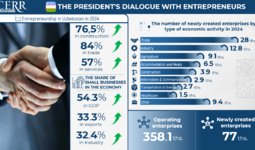Analysis of business activity in the context of Uzbekistan’s regions is monthly calculated by CERR on the basis of operational data (monitoring in all regions of the republic, according to the data of the State Customs Committee, State Oil Company, Central Bank and UzEX).
The monitoring results showed that the volume of tax revenues during the period from March 1 to March 31 of this year grew by 6.0% over the same period last month. At the same time, a significant increase in tax revenues was noted in Syrdarya (by 52.3%), Surkhandarya (by 33.0%), Kashkadarya (by 23.6%), Namangan (by 23.5%), Jizzakh (by 17, 4%), Tashkent (14.0%) regions, Tashkent city (10.8%) and the Republic of Karakalpakstan (21.3%).
The increase in tax revenues indicates a stable growth of economic activity and indicates favorable business expectations regarding the prospects for their development.
Receipts from customs payments for the analyzed period increased by 7.6%. The largest increase in the volume of receipts was noted in Khorezm (2 times), Syrdarya (49.9%), Andijan (49.7%), Surkhandarya (39.8%), Navoi (30.9%), Bukhara (by 20.9%) in the regions and in the Republic of Karakalpakstan (by 21.7%).
The growth in customs payments indicates an increase in foreign trade operations and expansion of production processes in the country due to the gradual increase in production capacity and the development of demand in the domestic market.
According to the State Customs Committee, the volume of exports of goods increased by 41.2%. The growth in the volume of exports goods was in Bukhara (by 90.9%), Kashkadarya (by 89.1%), Fergana (by 64.6%), Samarkand (by 55.1%), Surkhandarya (by 45.7%), Andijan (by 42.5%), Tashkent (by 29.0%), Syrdarya (by 26.9%), Khorezm (by 21.8%) regions, in Tashkent city (by 54.3%) and in the Republic of Karakalpakstan (by 39.4%).
The increase in the rate of export justifies the growth in the production of export-oriented goods and the increase in the competitiveness of domestic products which stimulates external demand for traditional Uzbek goods.
The volume of loans issued by commercial banks over the past month increased by 22.1%. The largest growth in the volume of issued loans is observed in Surkhandarya (2.1 times), Bukhara (2 times), Samarkand (2 times), Andijan (95.3%), Khorezm (51.0%), Jizzakh (by 36.8%), Namangan (by 34.0%) and Tashkent (by 23.4%) regions.
The growth in the volume of loans issued by commercial banks indicates the expansion of the production activities and their favorable expectations regarding the prospects for the development.
During this period, 8,794 new business entities were created, the largest number was registered in Samarkand (835), Tashkent (802), Kashkadarya (746), regions and in Tashkent city (1,482).
The volume of transactions at the Uzbek Republican Commodity and Raw Materials Exchange increased by 10.5%.
A significant increase in exchange activity is observed in Khorezm (by 80.6%), Jizzakh (by 39.6%), Fergana (by 33.5%), Andijan (by 31.8%) and Namangan (by 26.6%) areas.
The growth in the volume of transactions in these regions was ensured by an increase in the sale of such goods as gasoline, technical cotton seeds, cotton fiber, sugar, non-ferrous metals, diesel, cement, construction and household goods, ferrous metals, polyethylene, polypropylene, vegetable oil and mineral fertilizers. This is evidence of the growth in the activity of legal entities, an increase in the income of individuals, which gives impetus to the economic process and the activities of business structures.
The growth in the volume of transactions justifies the gradual recovery of the economy through the stabilization of both demand factors and supply, which is increased in mutual trade relations between business entities.
The growth of economic activity in 2021 is also evidenced by the results of the CERR study on the assessment of business activity in Uzbekistan. The study aims to give a consolidated calculation of the perception in the economy, to show the vector of business development and focusing Uzbek entrepreneurs.
Center for Economic Research and Reforms





















leave a comment